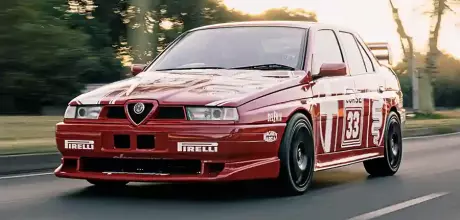1992 Alfa Romeo 155 GTA Stradale
I had threatened to produce a road going 155 GTA Stradale but only got as far as a single prototype. So, to hell with still — born projects of which the automotive world has amassed sheds full over the years.
WORDS JOHANN VENTER
IMAGES STEFAN KOTZE
Alfa Romeo 155 GTA Stradale
Enter Claudio del Gallo who decided to build his own 155 GTA and add some Italian racing flare to his obsessive plan.
“I was completely obsessed with the racing 155 GTA and that only became more intense when the 155 TI V6 DTM won the DTM in 1993,” Claudio begins.
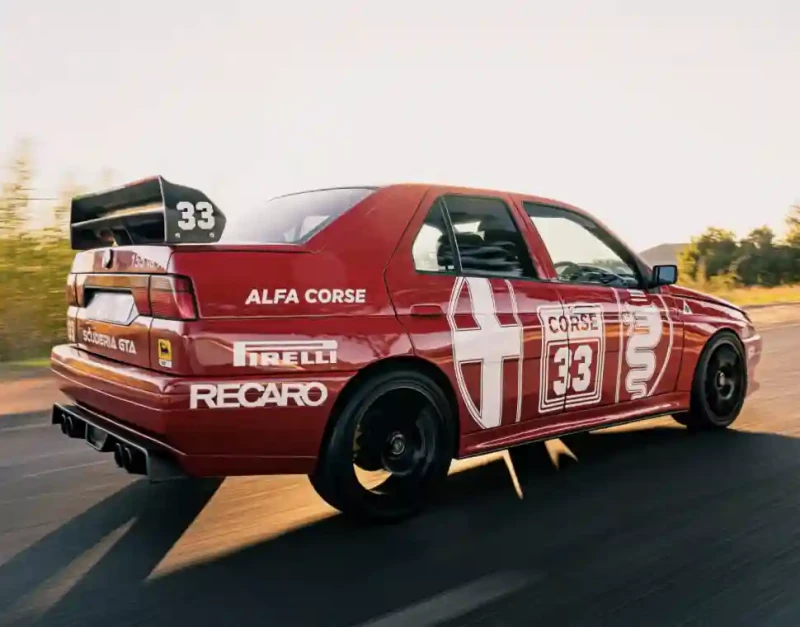
“And then Fiat faltered at the opportunity to create the 155 GTA Stradale road car, so I decided to make my own,” he declares.
Across these pages you will notice the unmistakable presence of a Lancia Stratos, one of the most celebrated rally cars of all time. Read more at the end of this feature in the footnote.
For now, let’s just get a better understanding of the Alfa Romeo 155 — the first Alfa that was designed from the ground up by Fiat, since its takeover of Alfa in 1986. Structurally it was built on the Fiat Tempra and Tipo platform. It replaced the Alfa 75 and took on a smoother approach to the wedge-shaped design, which had become ubiquitous with Alfa. The less angular curves meant it could achieve an impressive drag coefficient of just 0.29.

But the Alfisti were not impressed and the 155 received a frosty reception when it was launched in 1992. The front-wheel-drive architecture is what rattled the hornet’s nest, as purists and journalists alike felt that it was not fitting of the sporting heritage that the Alfa Romeo badge had garnered.
It was offered with the 1.7-litre, 1.8-litre and 2.0-litre Twin Spark engines. At the top of the pecking order was the ‘Busso’ 2.5-litre V6, adapted from the 3.0-litre V6 found in the 164, delivering 164bhp. And of course, the Q4 which was a Lancia Delta Integrale parading as a 155.
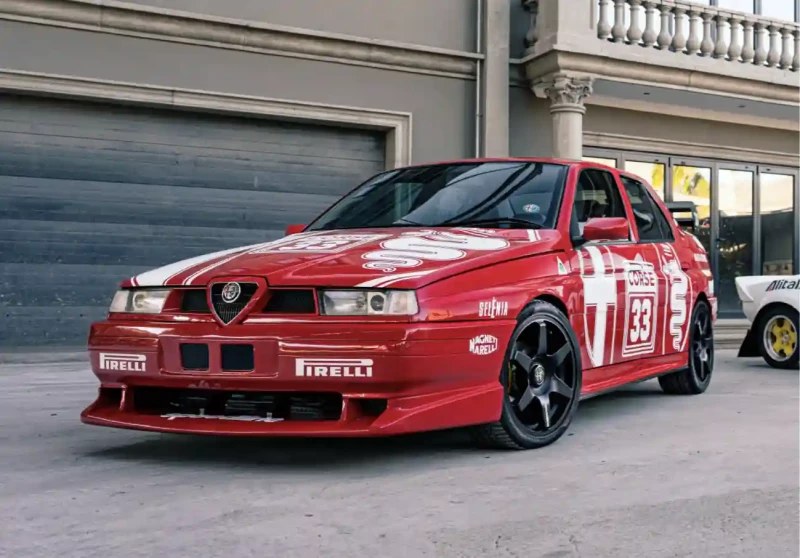
The Integrale underpinnings included the 2.0-litre, 16-valve, turbocharged drivetrain, good for 190bhp that is fed to the four-wheel-drive system which gave the Integrale its rallying credentials.
Owners of the 155 were however less than impressed with the handling of the car and Fiat heeded this concern, releasing the wide-body iteration in 1995. The wider body was to accommodate the wider track which included wider wheel arches which better suited the car.
The 155 also received an uprated steering mechanism which stemmed from the Alfa Corse 155s, called ‘Quick Rack’. These changes resulted in a much sharper steering and vastly improved the handling dynamics of the 155.
There were also engine upgrades for the four-pods, doubling valve capacity from eight to 16 and switching from chain — driven camshafts to belt-driven.

Production of the 155 ended in 1998 with 195,526 built after a six-year run.
The 155 had an illustrious racing career with development of the first competition example having started prior to the first production car driving off the factory floor. Fiat canned the Lancia WRC programme at the end of 1991 and moved Sergio Limone, head of Lancia Corse and his team to Alfa Corse, who had already started to develop a 155 contender for the 1992 Italian Superturismo Championship.
The 155 GTA used the Lancia Delta Integrale fundamentals, which include the four-wheel-drive system and the 2.0-litre 16-valve turbocharged four-cylinder engine which was capable of well over 400bhp — above and beyond what the Lancia was allowed under WRC regulations.
In 1992 Alfa returned to form after the Germans had dominated the Italian Superturismo Championship, ruling the roost from start to finish, with Nicola Larini taking the Championship. This was all a precursor to what Alfa really wanted, the crown jewels of the touring car racing — winning the DTM Championship.
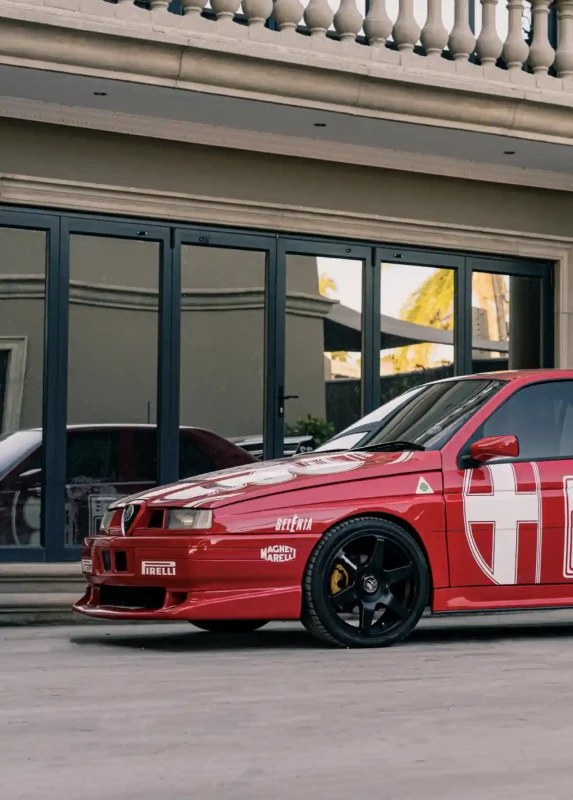
The Alfa Romeo 155 TI V6 DTM (then Deutsche Tourenwagen Meister, now: Deutsche Tourenwagen-Meisterschaft) made use of a longitudinally placed 2.5-litre, V6 engine, producing 420hp.
The tried and tested transverse six-speed, semi-automatic gearbox and four-wheel-drive system from the Lancia Delta Integrale was once again put into use. The 155 TI V6 DTM drew first blood at the opening round of the 1993 DTM season at Zolder, Belgium, with Larini qualifying on pole position and triumphing in both heats. Larini would go onto dominate the season with 10 wins from 20 starts, winning the 1993 DTM Championship with some of the most memorable battles against the Mercedes-Benz entrants.
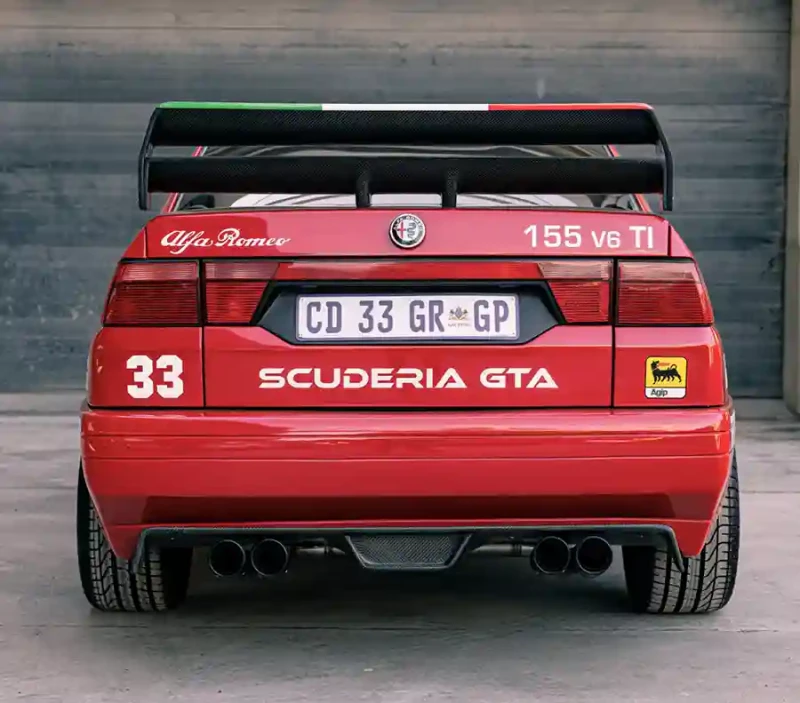
Alfa Corse’s crowning glory would be to also take the constructor’s title that year. Thus, making the Alfa Romeo the only manufacturer outside of Germany (and the 155 in particular) to have ever won the DTM title. It also managed to secure the most number of DTM victories between 1993 and 1996, racking up a total of 38. In 1994 the 155 secured both the British and Spanish Touring Car Championships and would go on to win the Spanish Touring Car Championships twice more in 1995 and 1997.
Hot on the heels of the highly victorious Italian touring car racing campaign in 1992, it was decided to develop a road going 155 GTA Stradale, to commemorate Alfa’s success on the track.
It was also meant to go after the BMW E30 M3 and Mercedes-Benz 190E market as both of those models had achieved success in touring car racing. The development of the 155 GTA Stradale was left to Abarth engineer, Sergio Limone.
Limone once again relied on the fundamentals of the Lancia Delta Integrale, which meant the 2.0-litre turbocharged four-cylinder engine, good for 190bhp and the four-wheel-drive architecture. On the outside it took on the aggression of the racing 155s, with substantially flared arches, deep, imposing, front spoiler with air intakes, pronounced side skirts, wider rear bumper and a substantial wing. It was presented to the Fiat management who felt that it needed a more powerful six-cylinder engine, that could also produce a deeper more distinctive sound – more in-line with the Alfa lineage.
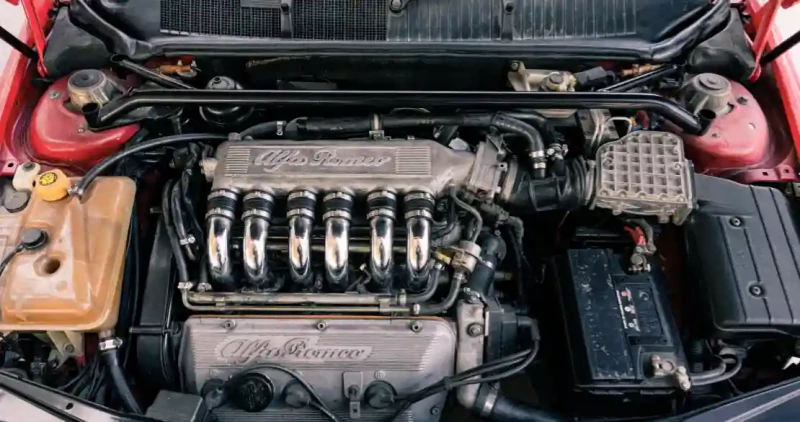
This in effect was the death of 155 GTA, as the six cylinder was not compatible with the Lancia Integrale four-wheel-drive suspension. A separate production-line would have to be developed for the 155 GTA, which would come at an astronomical cost, which the Fiat management duly turned down. The 155 GTA was however displayed at the Bologna Motor Show, in December 1994. That same year it also served as the medical car, at the Italian Formula 1 Grand Prix at Monza which was driven by Fabrizio Barbazza.
Thereafter it ended up in the hands of Tony Fassina, winner of multiple Italian Rally Championships, he sold it to a friend in Germany in 1998, it returned to Italy in 1999 when purchased by a collector.
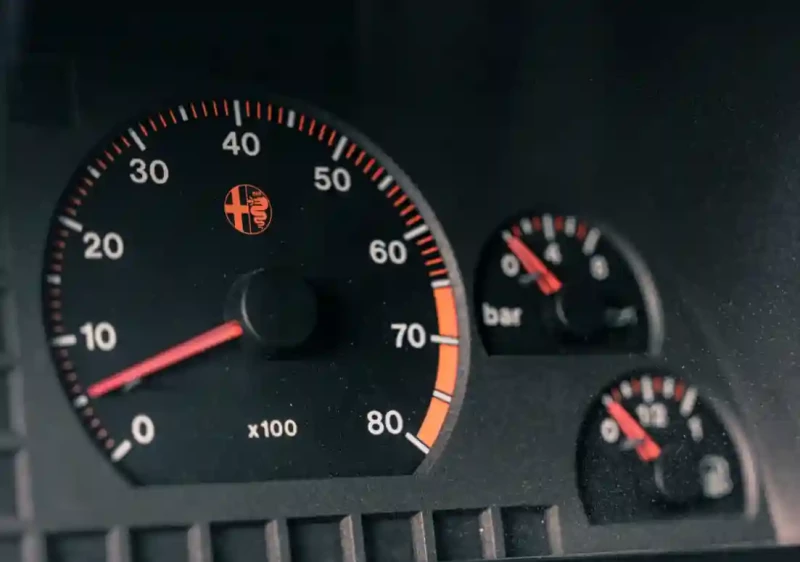
Subsequently it was purchased by Rino Anello and then put up for auction by Bonhams in Padua October 27, 2018, but did not sell. Zagato was also spurred on by the success of the 155 GTA and the 155 TI V6 and thought that he could convince Fiat to do a limited run of a road interpretation of the race car. The styling would mimic that of the race car with a wider track and blistered wheel-arches, a large front bumper with deeper spoiler, air intakes, Venturi lip and side skirts, at the back it would have a more pronounced bumper, lower spoiler and wing.
The suspension was uprated with adjustable gas dampers, variable rate springs and was also lowered by 1.34 inches and fitted with special 17-inch light alloy wheels. Like the race car it would be powered by the Lancia Delta Integrale 2.0-litre, 16-valve, turbocharged four-cylinder engine and would be driven by all four wheels.
Zagato named it the 155 TI. Z (Turismo Internazionale Zagato) and presented it at the Geneva Motor Show in March 1994, but unfortunately a struggling Alfa did not have the appetite. Undeterred, Luca Zagato turned to a Japanese investor to fund the project and registered a new company called Z Automobili, to produce the 155 TI. Z solely for the Japanese market. After all, Zagato had managed to sell over 100 Autech Stelvios in Japan a few years earlier. A total of 21 cars were hand-built in Italy and shipped to Japan, between 1995 and 1997. And 13 were equipped with the 2.0-litre Twin Spark, six were the Q4 derivative with Integrale engine and running gear. One received the V6 ‘Busso’ engine and was badged the GTA.Z, and one has remained a mystery in terms of the powertrain.

Let’s now turn our attention to the 155 in this feature. Claudio del Gallo is second generation Italian, and has owned this 155, 2.5-litre V6, for the last seven years. Over time Claudio has owned a couple of Alfas, which comes as no surprise.
They say that you are not a true petrolhead until you’ve owned an Alfa. He had sold his previous 155 ‘Busso’ which left a gaping hole in his heart, until he found this one.
“It has always been my dream to create my own Alfa Romeo 155 GTA…a cross between the outstanding racing cars and the road version of the GTA, which Alfa should have built. I’ve always had a passion for cars, with Alfas and Fiats having been the dominant forces. I’m a very patriotic Italian. I was at high school when the 155 GTA won the 1992 Italian Superturismo Championship. The following year Alfa entered the 155 in DTM, and the 155 was supreme that year, taking the championship. And for the next three years became the car to beat in German touring car racing,” he enthuses.
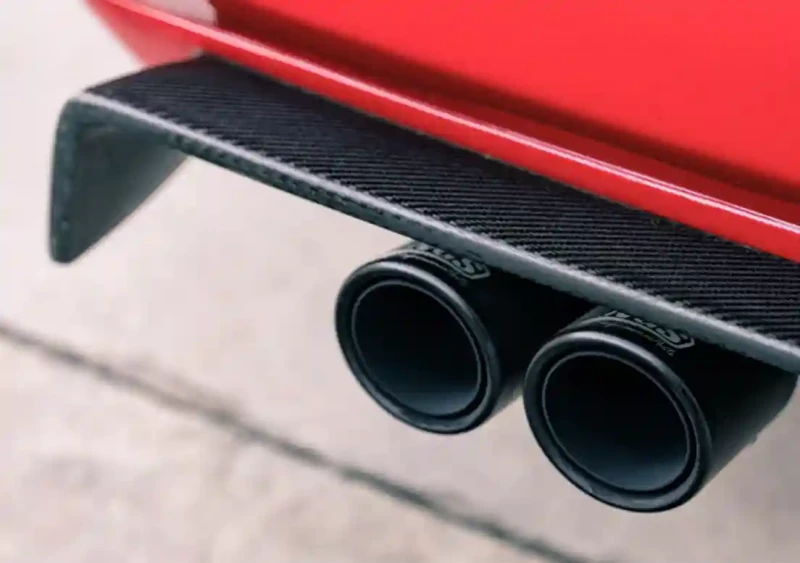
“So, from the outset I had a clear understanding of what I wanted this car to be, it had to have the ‘Busso’ motor (the V6 being reflective of the 155 TI V6 DTM), which were quite rare in South Africa. I had the 155 for barely a week before I started stripping it.
“I got in touch with Anton Dekker of Exclusive Conversions, to bring the vision in my head to life. I did plenty of research and found that no two race cars were the same and discovered quite a bit of variation.
I then provided numerous images to Exclusive Conversions which they emulated, to bring my manifestation to life. It is not representative of one car. Instead, I took what appealed to me, so you’ll see various elements from numerous different race cars and the same goes for the livery,” The aero appendages are reflective of the racing 155s. “The flared arches are made from fiberglass, as well as the bumpers, but the side-skirts, rear diffuser and wing are carbon fibre. I wanted this to be a road legal, usable car and therefore retained the interior with all its creature comforts and that is where the GTA road car comes into the equation.
“The engine has been balanced and blueprinted, whilst fitted with a 3.0-litre crankshaft for better compression, and the cylinder heads have been gas-flowed. To accentuate that legendary Alfa V6 soundtrack, I added a bespoke exhaust, which I think just sets off the right tempo. “The exhausts have carbon tips to complement the rest of the carbon elements.”
Sourcing the wheels proved a challenge with the resulting Speedline wheels purchased from the United States after a world-wide search to match what were used on the competition machines.
“I searched the world and was prepared to do anything. Eventually I found these Speedline wheels in the US. Initially the company selling them would not give me the time of day. I persisted and they put me in touch with a distributor in Joburg (Johannesburg), just to find that they did not have the PCD for the 155. I would have thought that they were centre lock wheels which is exactly the effect I was going for. I considered adaptor plates but could not bring myself to go that route.
“Then the Yanks contacted me, and my Italian charm had eventually paid off. They stated that they had received an order for blank wheels with no holes for the studs, and if I was still interested they could include a set for me as a favour. I jumped at the opportunity…the cost was stratospheric, but I had to have them.
Once the wheels arrived in South Africa, I had to have the holes drilled, that entire process took about two years,” he points out.
The phenomenal outcome is quite striking. The magnificent red paint covered in Alfa Corse livery of your choosing makes this an Italian masterpiece.
There is also an interesting reason why Claudio opted for #33 as part of the 155 GTAs battledress. “It is of great religious significance, del Gallo remarks. “Jesus died at the age of 33. If you look at the number plate it is CD 33 GR GP. I was issued this plate, it is not a personalised plate, but you could read it as Claudio del Gallo (CD 33 GR), and 33 to match the livery, while the ‘R’ stands for racing.”
The build process took four years which was blown out by the COVID-19 pandemic.
Claudio’s Stratos started life as a kit car, made by Carson Automotive Engineering in the UK. It was successfully raced in the UK and then made its way to the Western Cape, in South Africa, where it also campaigned.
Claudio found it 20 years ago in poor shape after years of racing. So, he then set about creating a Stratos Tribute that would be true to his vision of what a Stratos should be. The Honda/Rover 2.5-litre V6 was immediately abandoned and replaced with an Alfa 3.0-litre V6 quad-cam, which was later bored to 3.5-litres. It is finished in the Stratos East Africa Safari Rally livery, with gold wheels. Weighing only 880kg, it can achieve the 100km/h mark in under four seconds, in part thanks to the semi-slicks that have been fitted to improve traction.


